- Home
- Diana Wynne Jones
Reflections: On the Magic of Writing Page 9
Reflections: On the Magic of Writing Read online
Page 9
Fantasy certainly does provide comfort—and who is not entitled to a little comfort if they can get it? For those who need that, it is the mind’s perfect safety valve. But a child reading, say, a fairy story is doing a great deal more. Most fairy stories are practically perfect examples of narratives that fit the pattern of the mind at work. They state a problem as a “what if” from the outset. “What if there were this wicked uncle? That evil stepmother who is a witch? This loathsome monster?” Stated in this way, the problem (parent? bully?) is posed for the widest possible number of people, but posed in a way that enables the reader to walk all round it and see the rights and wrongs of it. This uncle, witch, or monster is a vile being behaving vilely. As these beings will invariably match with an actual person: parent, sibling, schoolfellow, what a child gains thereby is a sort of blueprint of society. Reading the story, he or she is constructing a mental map—in bold colors or stark black-and-white—of right and wrong and life as it should be. Turning to the actual parent or schoolfellow, where right and wrong are apt to be very blurred, this child will now have the mental map for guidance.
An important part of this mental map is that the story should usually have a happy ending—or at least an ending where justice is seen to be done to villains and heroes alike. This is again part of life as it should be. The mind, as I have said, is programmed to tackle problems, joyfully, with a view to solving them. An ending that suggests—because the writer believes it to be “realistic”—that all you can attain is some lugubrious half measure, means that all children will set out to achieve will be that half measure. And, since you rarely achieve all you aim for, what these children will actually get is an even drearier quarter measure, or less. So it is important that the blueprint instructs them to aim as high as possible.
If you bear in mind these responsibilities as you write, you need have no fear that any child will mistake the blueprint for the actual world. Children recognize the proper workings of the imagination when they are allowed to see it and may quite well remember your story, joyfully and gratefully, for the rest of their lives.
The Heroic Ideal: A Personal Odyssey
Children’s Literature New England, which was founded in 1987 “to promote awareness of the significance of literature in the lives of children,” sponsors annual Summer Institutes on topics of interest to teachers, librarians, critics, and authors. The topic for 1988, presented at the Massachusetts Institute of Technology, was “The Heroic Ideal in Children’s Books: Legacy and Promise,” for which Diana Wynne Jones was invited to discuss her own work in relation to the theme of “The Heroic Ideal.” The following talk was then first published in the journal The Lion and the Unicorn, Volume 13, Number 1, June 1989 (Johns Hopkins University Press).
Good evening. It is very kind of you to want me here. I feel very honored to be asked. I am also very lucky to be here. I have this travel jinx, you see. Something always goes wrong. This time it manifested early, when the ticket I had booked was mysteriously canceled. . . .
I have subtitled this talk “A Personal Odyssey.” Hackneyed though this is, I think you will find before the end that it is relevant in more than one way. My first reason for calling it this is that I have never been able to think of heroes or the heroic without taking them to some extent personally—particularly when I was asked to talk about these topics in relation to my book Fire and Hemlock.
Obviously we have to start with some basic definition of the hero and the heroic ideal. Having done that, I’d like to touch briefly on the way I found it to apply to children’s books in general, and then go on to Fire and Hemlock in particular.
As a child, I was an expert in heroes. The eccentricity of my parents meant that there were almost no books in the house except learned ones, or books they used for teaching—and I was an avid reader. So before I was ten I had read innumerable collections of Greek myths, including Hawthorne’s Tanglewood Tales, and the unabridged version of the Morte d’Arthur, in double columns and tiny print, from which, besides being very puzzled about just what Lancelot was doing in Guinevere’s room, I made a mental league table of the Knights of the Round Table: Galahad went even below Kay, as a prig—my favorite was Sir Gawain. I also read Pilgrim’s Progress and folktales innumerable from all over the world, including all of the Grimm—and also a certain amount of Hans Andersen, but as Andersen reputedly made his stories up my parents only admitted him to their house in limited quantities. I then went on to the Odyssey, which I preferred to the Iliad.
I was saddened to find that, as an eldest child and a girl, I was barred from heroism entirely—or was I? I puzzled long over the story of Hero and Leander.1 Hero did nothing but let her lover do all that swimming. Obviously the girl was a wimp. But she had that name. When I was nine, much pleading wrung a frivolous book from my parents—The Arabian Nights, bowdlerized. Scheherazade, I was delighted to find, was an elder sister. So even though she did nothing but tell stories (literally for dear life), maybe there was some hope. I found it later in that book, in a tale in which the sultan’s jealous sisters tell the sultan that his wife had given birth to a puppy, a kitten, and a log of wood. The log of wood was a girl, and she most heroically set things to rights. Good. It was possible for a girl to be a hero, then.
By this stage, I had acquired a firm mental grasp of what a hero is. A hero, first, is the one you identify with in the story. (Although this is not quite intrinsic to heroism, it is a fact that keeps flowing back into the definition and influencing it in all sorts of way. When I later read Paradise Lost, I saw at once that Milton had made the mistake of ignoring this.) Otherwise, heroes are brave, physically strong, never mean or vicious, and possess a code of honor that requires them to come to the aid of the weak or incompetent and the oppressed when nobody else will. In addition, most heroes are either related to, or advised by, the gods or other supernatural characters. The gods (even if they only appear in the form of fate) are important for heroism for two reasons. First, they supply a huge extra set of dimensions that put the hero in touch with the rest of the universe and render his actions significant for the whole of humanity. Second, the fact that the god, or gods, are watching over him serves to keep the hero up to his code. If he does chance to behave in a mean or vicious way—or break any of the other rules, for that matter, which are part of the world of that particular story—then he is at once punished and corrected.
But above all, heroes go into action when the odds are against them. They do this knowingly, often knowing they are going to get killed, and for this reason they impinge on a hostile world in a way others don’t. When they die, their deaths are glorious and pathetic beyond the average.
Now this probably sums up Hector of Troy, and Hercules, and certainly applies to King Arthur—who has a double supernatural dimension, since he is guided both by Merlin and the Christian God—but I was aware that it did not quite apply to people like Jason; or to Theseus, who coolly abandoned Ariadne on an island; or to the heroes of innumerable folktales who, like the Brave Little Tailor, start their heroic careers with a gross deception; nor, particularly, did it apply to Odysseus. Odysseus, while being billed as every inch a hero, nevertheless conned and tricked and sweet-talked his way all round the Adriatic. This used to worry me acutely. I was quite aware, of course, that Odysseus belonged to the second type of hero—the foxy, tricksy hero, the hero with a brain—but this being the case, was it proper to regard him as a hero at all? For a long time I felt I only had Homer’s word for it—that he was only a “hero” in the sense of being the person you identified with in the story. Then it dawned on me that the most heroic thing Odysseus does was never properly explained in my translation of the Odyssey (maybe Homer doesn’t explain it anyway). This was to have himself tied to the mast with his ears open, while his sailors plugged their ears and rowed past the sirens. My translation represented this simply as a sort of musical curiosity on Odysseus’s part: he wanted to hear whatever it was the sirens did. But if you look at this episode from th
e point of view of the rules of magic, you see at once that it is a calculated attempt to break the sirens’ spell. Obviously, if a man could hear their irresistible song and yet resist them, this would destroy the power of the sirens for good. As soon as I saw this, I realized that Odysseus was a real hero.
Around this time, my grandmother gave me a book she had won at the age of six as a Sunday school prize (which she confessed she had chosen for its grand and incomprehensible title). It was called Epics and Romances of the Middle Ages. It contained almost every heroic legend from northern Europe that was not part of the Arthurian cycle: the Charlemagne cycle, the stories connected with Dietrich of Berne, the entire Nibelung cycle, including the bits that Wagner did not use, the story of Beowulf and of Wayland Smith, and many more, all illustrated with wonderful woodcuts but otherwise in no way adapted for children. I read it until it fell to pieces. Many of the stories were unutterably sad, particularly those in which the gods took a hand—so much so that, when I later heard the saying “Those whom the gods love die young,” I thought that, though thoroughly unfair, it was probably a profound truth.
Out of all this reading I had by now the basic hero story well plotted. Your average hero starts out with some accident of birth, parentage, or person which sets him apart from the rest and often, indeed, causes him to be held in contempt. Even if he seems normal, he has at some point to contend with his own physical nature (as when Beowulf fights the dragon as an old man, or when Odysseus listens to the sirens). Nevertheless, he sets out to do a deed which no one else dares to or at which others have horribly failed. The story often does not state the heroic code that demands this. That only manifests when, along the way, the hero’s honor, courage, or plain niceness causes him to befriend some being who will later come powerfully to his aid. (This is one of the places where being a hero overlaps with “being the person in the story with whom we identify,” because your hero is after all also your goodie.) After this, he may well make some appalling mistake: as Christian strays from the straight and narrow path, or Siegfried forgets Brunhilde—and this lands him deep in trouble. He can then end tragically. Or he can call in the debt from the powerful being he befriended earlier and, with difficulty, prevail.
So much for the male heroes. But it seemed to me that the women were a mess. All over the world they were either goaded into taking vengeance, like Medea, or Brunhilde in my grandmother’s book, or they are passive, like Hero or Andromeda or Christiana. A medievalist I consulted about this opined that Christianity had substantially affected the heroic ideal, especially where women were concerned, by introducing ideas of patience and endurance and the solitary personal struggle against one’s own fleshly instincts. But you have only to look at the stories I have cited already to see that all these things are there in pre-Christian heroic stories. There seems to have been an overwhelming acceptance that meekness was the lot of a good woman, until she was goaded into turning evil. In the Odyssey, Penelope can only stay good by tricksy passive resistance which doesn’t do much to get rid of her suitors. But at least she was using her mind—like her husband.
By this time I was adding the rest of an education to this childhood reading. This involved reading Chaucer’s Canterbury Tales. And here I found a man writing who was more subtle than Odysseus, playing with the kind of narratives I had previously enjoyed, telling them in different styles, delicately deflating the typical hero, altering the balance of the tale with sophisticated touches (not least of which was making some tales almost too appropriate to their tellers, as in “The Clerk’s Tale,” where he has the ultimate female wimp). And most ironical and sophisticated of all, he tells the most truly and obviously heroic story—“Sir Thopas”—pretending it is from his own mouth, and makes it an utter joke, a complete send-up. It was as if a super-Odysseus had passed that way, listening with a delicate and caustic ear to the siren song of my childhood stories and breaking their spell entirely. I didn’t quite see this at the time, but I was left with an uneasy sense that the heroic ideal was awfully banal and naive and straightforward.
When I got to Oxford as a student I came to see that this was how these stories seemed now to everyone once Chaucer had done with them. No respectable writer dared for centuries to write a straightforward heroic narrative. If you wanted to, you had to show that your narrative had a purpose that was not heroic; either to strip the illusions from a naïve hero like Candide or Tom Jones (Tom Jones, interestingly enough, was based on the Odyssey), or to make a moral and social point aside from the story as, say, Dickens does. And the bad things to be conquered had to be reduced to credible everyday targets, like the government. Not surprisingly, by the twentieth century, tricksy Odysseus-like heroes came to be preferred (Raymond Chandler’s Marlowe is typical) if you still stubbornly wanted any element of heroism or naive storytelling. And the whole thing reached an apotheosis in a non-heroic non-story by James Joyce, called, appropriately enough, Ulysses. In the midst of all this I was very grateful to come across a writer called Edmund Spenser who had managed to retrieve at least six genuine heroes from this mess and put them in a narrative called The Faerie Queene. This is an allegory. Even in Tudor times you couldn’t do it straight and be thought serious (I may remind everyone that Shakespeare didn’t consider his plays serious: his serious stuff was Venus and Adonis, where the decoration almost hides the story).
To my joy, one of Spenser’s heroes was a woman. Britomart. Now, I haven’t space to go into everything I learned from Spenser—things such as how to organize a complex narrative, or how to implant the far-off supernatural into the here and now—but I must pause a bit on what a discovery Britomart was to me. A woman who was a proper hero (this may be a commonplace now, but it certainly was not in the fifties). True, she was also an allegory of Chastity and dressed in armor like a man, but the significant thing to me was that she had a vision of her future lover and set out to do something about it as a hero should. The vision of the future lover is of course a common folktale element. But in The Faerie Queene the vision serves as the high ideal, the thing to strive toward, and it is also, in plain human terms, love. And here I began to see just what Christianity had really added to the heroic tradition. It had reinforced the high ideal—for God is love—but heroes have always had that, even if they do not know it when they begin; but, more importantly, Christianity had modified the tradition that a hero is guided by a god or gods. For God watches over everyone. Thanks to Britomart and Spenser, I now knew that every ordinary man or woman could be a hero.
But the heroic ideal, I thought, had gone sour. It was not until I had children of my own and through them came to read the children’s books I had never had as a child, that I realized that here was the only place where the ideal still existed. It flourished alongside the story, since children will not read much without a narrative, in a way that leads me to suspect the two things are closely connected. (Both ideal and story have since begun to flourish again in adult fantasy, but this hardly existed at the time I’m talking of: Tolkien had published only part of The Lord of the Rings.)
I think the reason that the heroic ideal had, as it were, retreated to children’s books is that children do, by nature, status, and instinct, live more in the heroic mode than the rest of humanity. They naturally have the right naive, straightforward approach. And in every playground there are actual giants to be overcome and the moral issues are usually clearer than they are, say, in politics. I shall never forget the occasion when I was visiting a school as a writer and the whole place suddenly fell into an uproar because the school tomboy—a most splendid Britomart of a girl—had beaten up the school bully. Everything stopped in the staff room while the teachers debated what to do. They wanted to give the tomboy a prize, but decided reluctantly that they had better punish her and the bully too. They knew that if, as a child, you do pluck up courage to hit the bully, it is an act of true heroism—as great as that of Beowulf in his old age. I remember passing the tomboy, sitting in her special place of punishment o
pposite the bully. She was blazing with her deed, as if she had actually been touched by a god. And I thought that this confirmed all my theories: a child in her position is open to any heroic myth I care to use; she is inward with folktales; she would feel the force of any magical or divine intervention.
On the other hand, it is clear to me that children don’t actually demand magical events in their reading. They differ as other people do. But it is a fact that all children’s books that endure are fantasies of some kind. These seem to strike the deepest note.
Anyway, you must picture me in the seventies all set to write according to these discoveries. But there was a snag. In 1970, no boy would be seen dead reading a book whose hero was a girl. Children were then—and still are to some extent—rather too inward with the heroic tradition that heroes are male and females are either wimps or bad. Girls will read male-hero stories and (wistfully) identify, but not vice versa, not in 1970 anyway. I took this up rather as a challenge: I love a challenge. For instance, I made David in Eight Days of Luke a boy, but I put him in a situation with his relations that both sexes could identify with. In Power of Three, I provided Gair with a sister with apparently greater gifts, and the same in Cart and Cwidder; and I sneaked a female hero past in Dogsbody by telling the story from the dog’s point of view. But a desire was growing in me to have a real female hero, one with whom all girls could identify and through that, all persons—a sort of Everywoman, if you like. This is the reason for the name Polly, when I eventually came to write Fire and Hemlock. The Greek poly means “more than one; many or much,” and this, as we shall see, has more than one significance for the book. Another thing I had also long wanted to do was to show children how close to the old heroic ideal they so often are. I’d had a stab at it in Eight Days of Luke, by using the days of the week and the Norse gods they were named after to indicate that the big things, the stirring events—the heroic ideal—were as much part of modern everyday life as Tuesday, Wednesday, and Thursday are. But I knew that what I wanted to do really was to write a book in which modern life and heroic mythical events approached one another so closely that they were nearly impossible to separate. I also longed to base something on the ballad “Tam Lin,”2 because that had one of the few Britomart-like heroes in folklore.

 Fire and Hemlock
Fire and Hemlock Reflections: On the Magic of Writing
Reflections: On the Magic of Writing The Game
The Game The Crown of Dalemark
The Crown of Dalemark Deep Secret
Deep Secret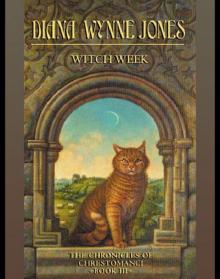 Witch Week
Witch Week Year of the Griffin
Year of the Griffin Wild Robert
Wild Robert Earwig and the Witch
Earwig and the Witch Witch's Business
Witch's Business Dogsbody
Dogsbody Caribbean Cruising
Caribbean Cruising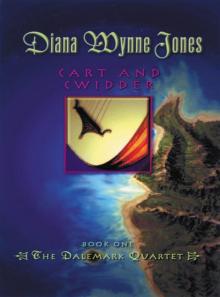 Cart and Cwidder
Cart and Cwidder Conrad's Fate
Conrad's Fate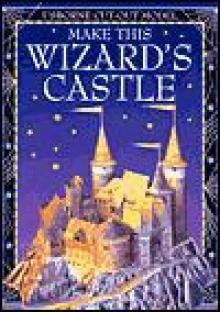 Howl's Moving Castle
Howl's Moving Castle The Spellcoats
The Spellcoats The Pinhoe Egg
The Pinhoe Egg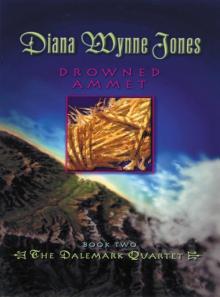 Drowned Ammet
Drowned Ammet The Ogre Downstairs
The Ogre Downstairs Dark Lord of Derkholm
Dark Lord of Derkholm Castle in the Air
Castle in the Air The Magicians of Caprona
The Magicians of Caprona A Tale of Time City
A Tale of Time City The Lives of Christopher Chant
The Lives of Christopher Chant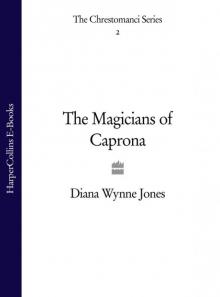 The Magicians of Caprona (UK)
The Magicians of Caprona (UK)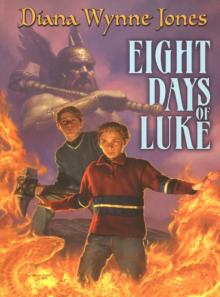 Eight Days of Luke
Eight Days of Luke Conrad's Fate (UK)
Conrad's Fate (UK)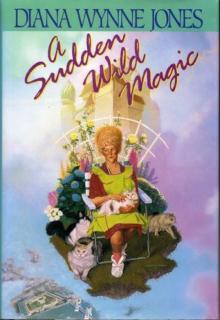 A Sudden Wild Magic
A Sudden Wild Magic Mixed Magics (UK)
Mixed Magics (UK) House of Many Ways
House of Many Ways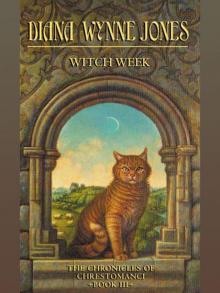 Witch Week (UK)
Witch Week (UK) The Homeward Bounders
The Homeward Bounders The Merlin Conspiracy
The Merlin Conspiracy The Pinhoe Egg (UK)
The Pinhoe Egg (UK) The Time of the Ghost
The Time of the Ghost Hexwood
Hexwood Enchanted Glass
Enchanted Glass The Crown of Dalemark (UK)
The Crown of Dalemark (UK)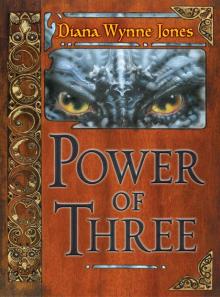 Power of Three
Power of Three Charmed Life (UK)
Charmed Life (UK) Black Maria
Black Maria The Islands of Chaldea
The Islands of Chaldea Cart and Cwidder (UK)
Cart and Cwidder (UK) Drowned Ammet (UK)
Drowned Ammet (UK) Charmed Life
Charmed Life The Spellcoats (UK)
The Spellcoats (UK) Believing Is Seeing
Believing Is Seeing Samantha's Diary
Samantha's Diary Aunt Maria
Aunt Maria Vile Visitors
Vile Visitors Stopping for a Spell
Stopping for a Spell Freaky Families
Freaky Families Unexpected Magic
Unexpected Magic Reflections
Reflections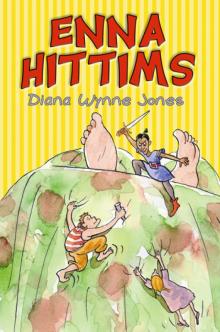 Enna Hittms
Enna Hittms Mixed Magics: Four Tales of Chrestomanci
Mixed Magics: Four Tales of Chrestomanci